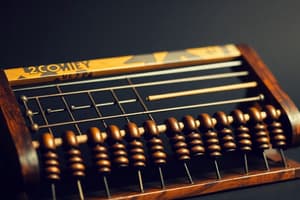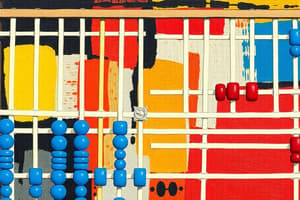Podcast
Questions and Answers
What does Oughtred's Slide Rule allow users to do?
What does Oughtred's Slide Rule allow users to do?
Perform calculations using logarithms
What is the first guide information processing tool developed in China?
What is the first guide information processing tool developed in China?
Abacus
Who invented Napier's Bones and in what year?
Who invented Napier's Bones and in what year?
John Napier, 1617
What additional functions could Leibniz's Calculator perform aside from addition and subtraction?
What additional functions could Leibniz's Calculator perform aside from addition and subtraction?
What is Charles Babbage often referred to as in the context of computing?
What is Charles Babbage often referred to as in the context of computing?
In what year did Blaise Pascal devise his calculating device?
In what year did Blaise Pascal devise his calculating device?
What invention began in 1822 by Charles Babbage aimed at calculating the roots of polynomials?
What invention began in 1822 by Charles Babbage aimed at calculating the roots of polynomials?
What is the Abacus?
What is the Abacus?
Who invented Napier's Bones and in what year?
Who invented Napier's Bones and in what year?
What is the purpose of Oughtred's Slide Rule?
What is the purpose of Oughtred's Slide Rule?
What capability did Pascal's Calculator have?
What capability did Pascal's Calculator have?
What additional operations could Leibniz's Calculator perform compared to Pascal's?
What additional operations could Leibniz's Calculator perform compared to Pascal's?
Who is considered the father of modern computers?
Who is considered the father of modern computers?
What was the purpose of Babbage's Difference Engine?
What was the purpose of Babbage's Difference Engine?
Flashcards are hidden until you start studying
Study Notes
Earliest Computing Devices
- The earliest data processing was done manually with mechanical devices due to lack of electricity and industrial technology
- The abacus is the first known information processing tool, advanced in China in the 12th Century, and used beads on rods to compute math
- John Napier, a Scottish mathematician, invented logarithms and used them to simplify math problems with manipulation of "bones"
- Napier's bones were a set of eleven rods made of bone or ivory, each with a number marked on them, the product of numbers could be attained by placing the rods side by side
- The Oughtred’s Slide Rule invented in 1620 by William Oughtred was a pair of movable rulers that allowed for proportional measurements
- Blaise Pascal, a French mathematician and physicist invented a calculating device known as Pascal’s Calculator in 1645, it allowed for addition and subtraction of numbers and was operated by chains of wheels
- Leibniz's Calculator, invented by Gottfried Leibniz, added multiplication and division, as well as square roots to Pascal’s Calculator
- Charles Babbage, an Englishman considered the father of the modern computer, invented the "Difference Engine" in 1822, which automated polynomial calculations
- The Difference Engine relied on the principle that the difference between certain values is constant
The First Generation of Computers (1940 - 1956)
- The First Generation employed vacuum tubes, making them large, bulky and prone to heat
- They used machine language for programming, and were slow and expensive
- They were used for scientific and military applications
- ENIAC, a general-purpose computer, was one of the first electronic computers, finished in 1946
- UNIVAC was the first commercial computer
- The First Generation was also known as the "Giant Brain" era because the computers were very large and complex
The Second Generation (1956 - 1963)
- Silicon transistors replaced vacuum tubes, making the devices smaller, faster and more energy-efficient
- Transistors were less expensive to produce than vacuum tubes which made computers more affordable for businesses
- This era saw the development of magnetic core memory
- The Second Generation used assembly language for programming, which was easier to learn, making usage for more people possible
- The Second Generation computers were used for a variety of applications such as business, science, and government
Third Generation (1964 -1971)
- Integrated circuits replaced transistors
- The third generation saw the development of operating systems which handled input, output, and memory management
- The third generation saw miniaturization in computers and lower costs
- The third generation saw the use of high level programming languages that were easier to use, resulting in increased accessibility
- The third generation computers began to be used in education, healthcare, and banking
- The third generation computers, due to their size and capability, were commonly referred to as a "computer revolution"
- The development of Minicomputers, smaller and less expensive than the previous generation computers
Fourth Generation (1971 - Present)
- The use of Microprocessors, which brought about the advent of the personal computer in the mid 70s
- The Fourth Generation saw the development of personal computing and user friendliness
- This era saw the development of graphical user interfaces, the use of networking and the internet
- The development of supercomputers with advanced computing power
- The Fourth Generation computers saw a wider range of applications, including artificial intelligence
- The Fourth Generation saw growth in storage capacity, faster processing speeds and increased memory
- The Fourth Generation saw increased use of web-based technologies, cloud computing and e-commerce
Fifth Generation (Present and beyond)
- The Fifth Generation focuses on artificial intelligence, parallel processing and high-speed computing
- The Fifth Generation saw the development of expert systems, natural language processing, and robotics
- The Fifth Generation sees computers that can translate languages, diagnose medical conditions, etc, with human-like capabilities
Classification of Computers
- Size, speed, capacity and cost are some common factors used to classify computers
- Computers need not necessarily be the same to be considered computers
- Classification can be based on the overall purpose of the computer, whether it is for general or specific tasks
- Computers can be classified through generation, technology, and cost
Types of Computers
- Personal Computers (PC): single user, desktop or laptop, used for general tasks
- Workstations: powerful single user, usually used for specific tasks, such as graphic design, video editing, or scientific research
- Mainframes: larger, more powerful, used by large organizations or institutions for complex tasks
- Supercomputers: very powerful, used for scientific and research purposes, handle massive data computations
- Servers: used for sharing resources between multiple clients in a network
- Embedded Computers: small computers built into other devices like cars, appliances, or phones, used for specific functions
Earliest Computing Devices
- The abacus, invented in China around the 12th century, was the first known device used for information processing. It consisted of beads strung on wires or rods, and mathematical calculations were performed by manipulating these beads.
- John Napier, a Scottish mathematician, invented "Napier's Bones" in 1617. It was a set of eleven rods made of bone or ivory, each with a number marked on them. These rods allowed users to calculate the products and quotients of large numbers by simply placing the rods side by side.
- William Oughtred, an English mathematician, invented the "Oughtred's Slide Rule" in 1620. This device consisted of movable rulers positioned alongside each other. Each ruler had markings that were proportional to the logarithms of the numbers, allowing users to perform various mathematical calculations.
- Blaise Pascal, a French mathematician, designed the "Pascal's Calculator" in 1645. This device could add and subtract numbers and was operated via a chain of wheels. It was about the size of a cigar box and could handle numbers up to 8 digits.
- In the mid-17th century, Gottfried Leibniz, a renowned scientist, developed a machine that performed mathematical calculations and saved labor. While the machine used the same principles of addition and subtraction as Pascal's calculator, it offered additional functionalities like multiplication, division, and square root extraction.
- Charles Babbage, an English mathematician in the 19th century, is considered a pioneer of modern computing. Although he couldn't fully develop the device, his ideas were instrumental in laying the groundwork for modern computers. He began working on the "Difference Engine" in 1822, which aimed to automate the calculation of polynomial roots. This device functioned based on the principle that the difference between consecutive values in certain formulas remains constant.
Studying That Suits You
Use AI to generate personalized quizzes and flashcards to suit your learning preferences.




